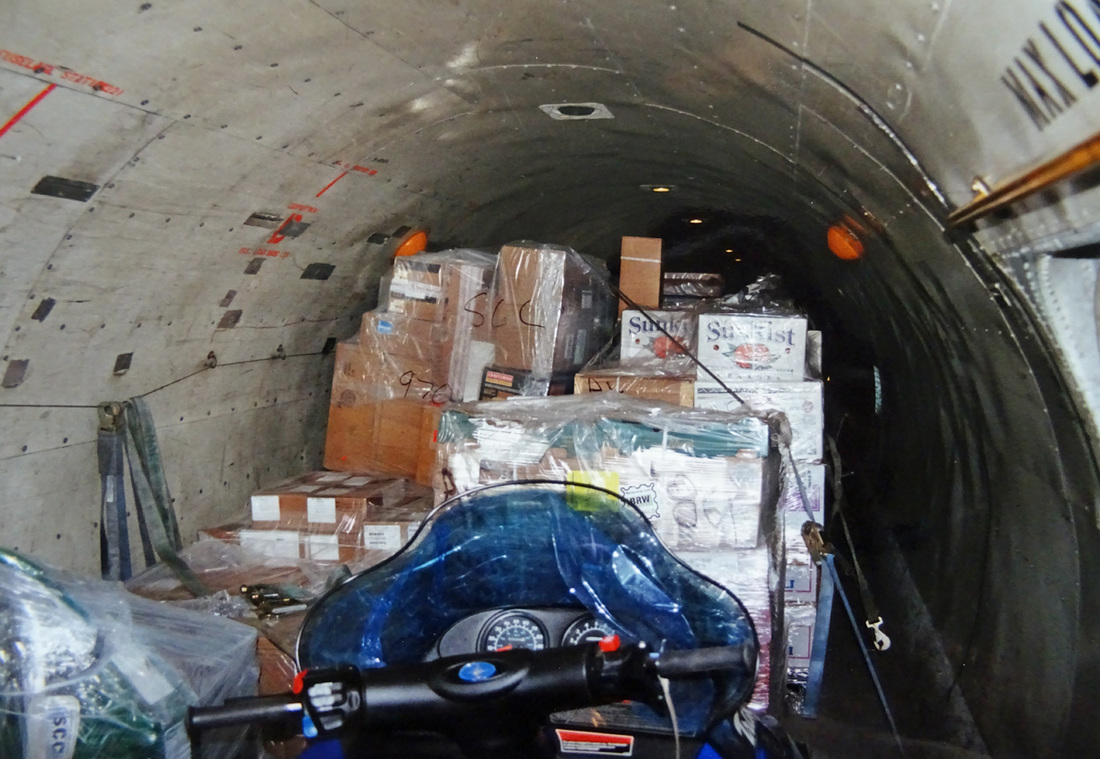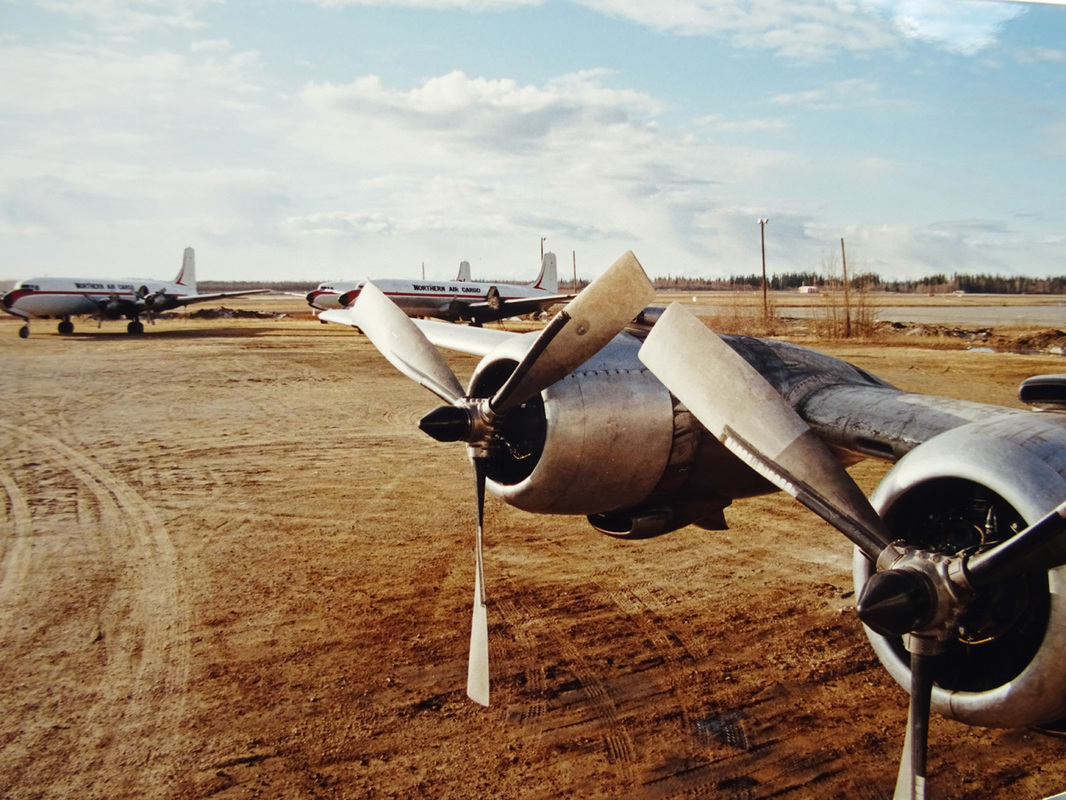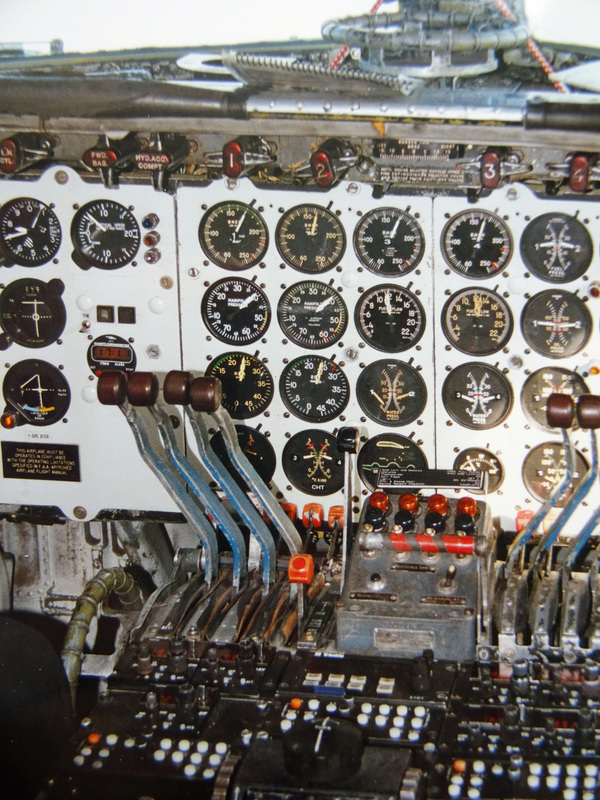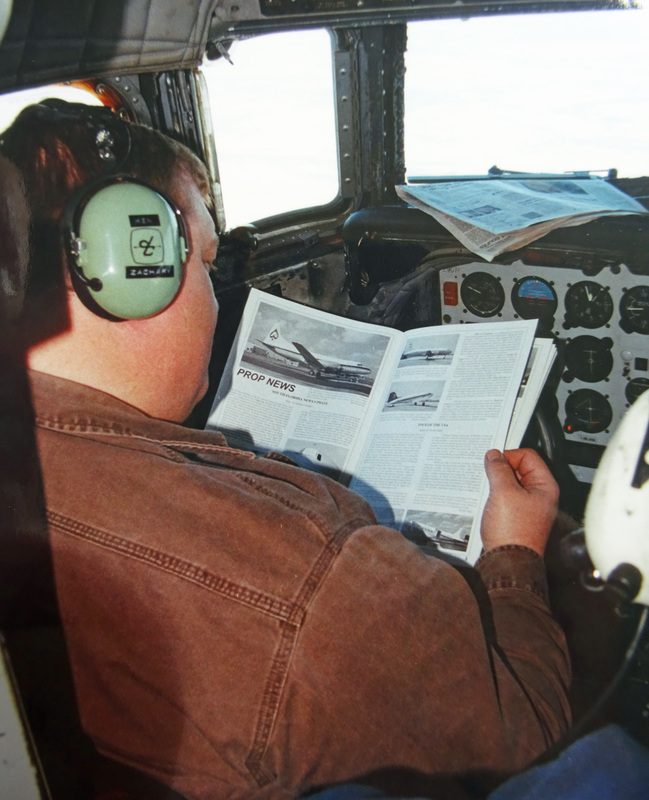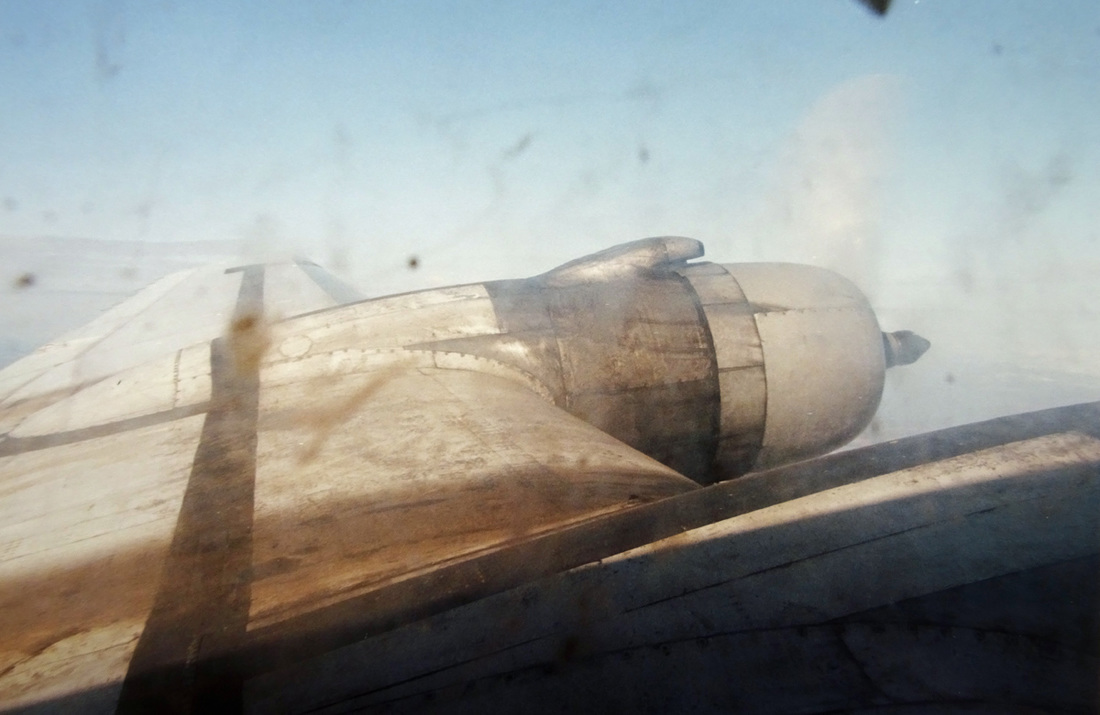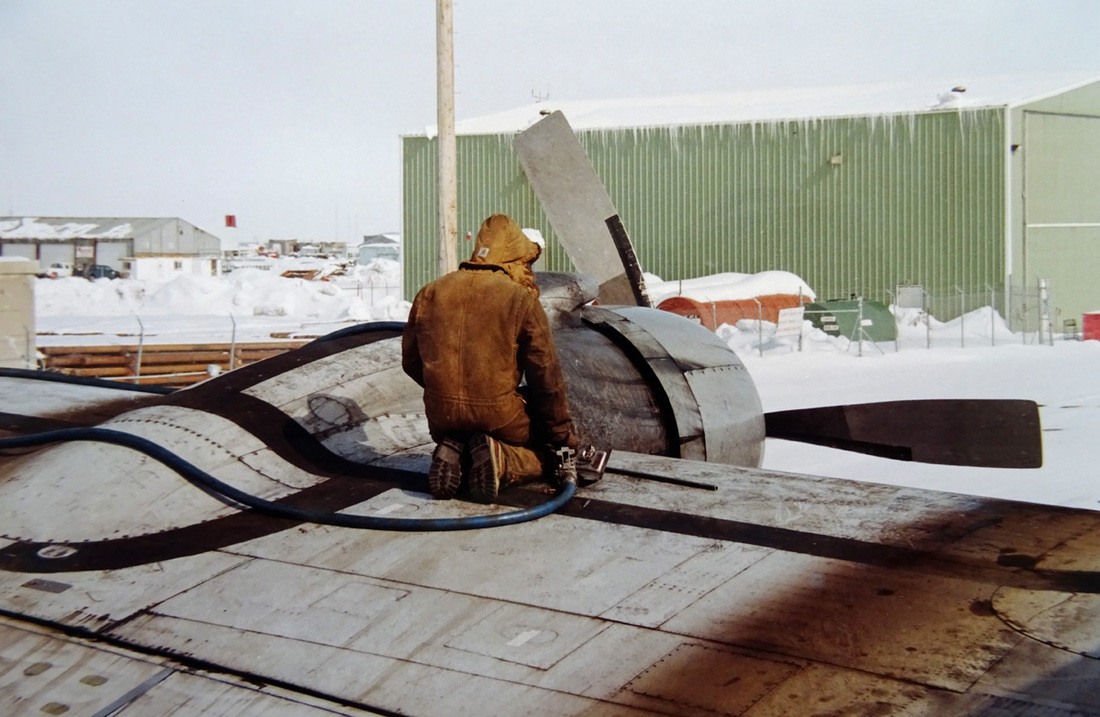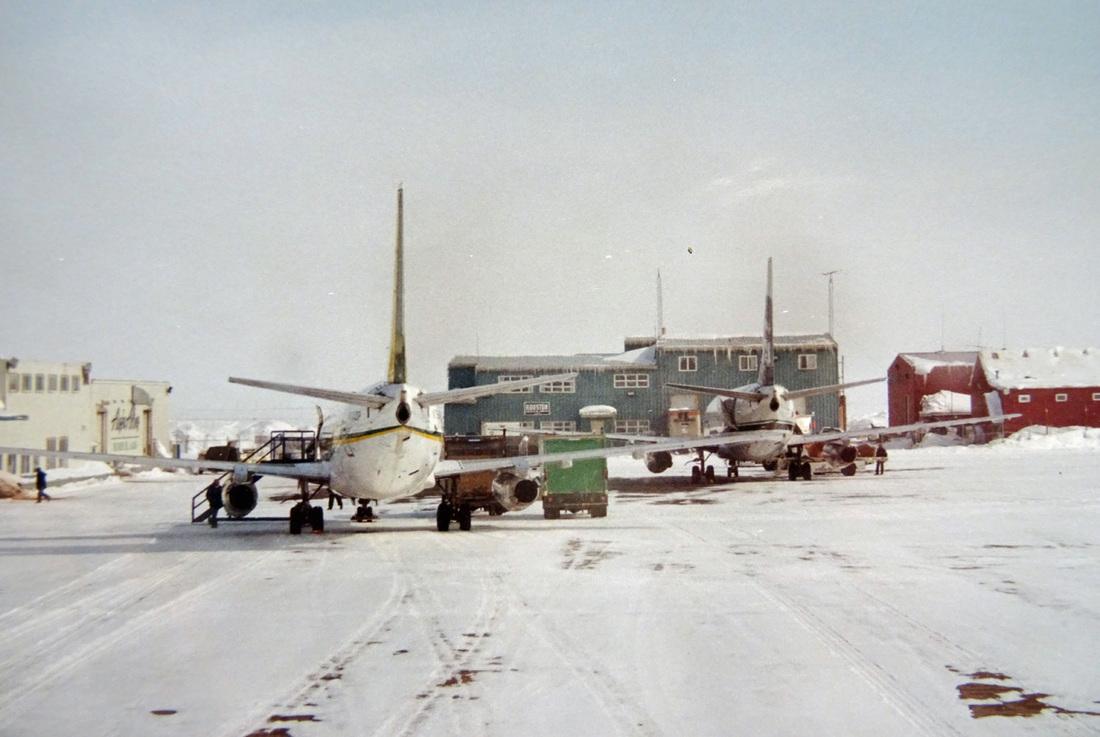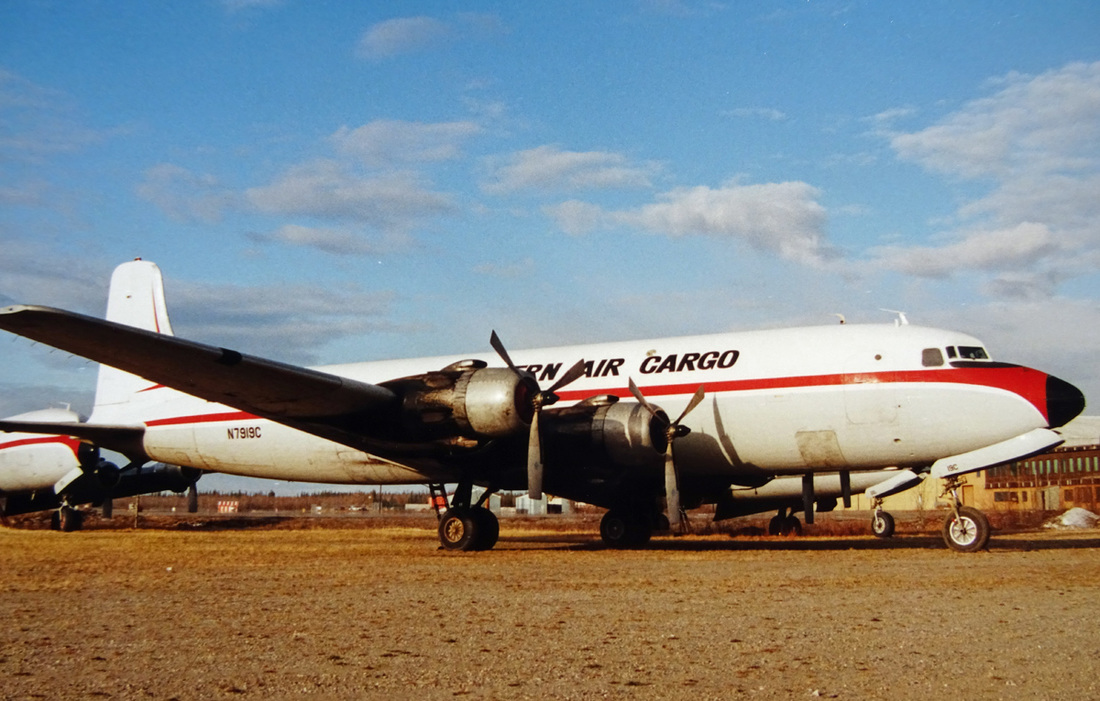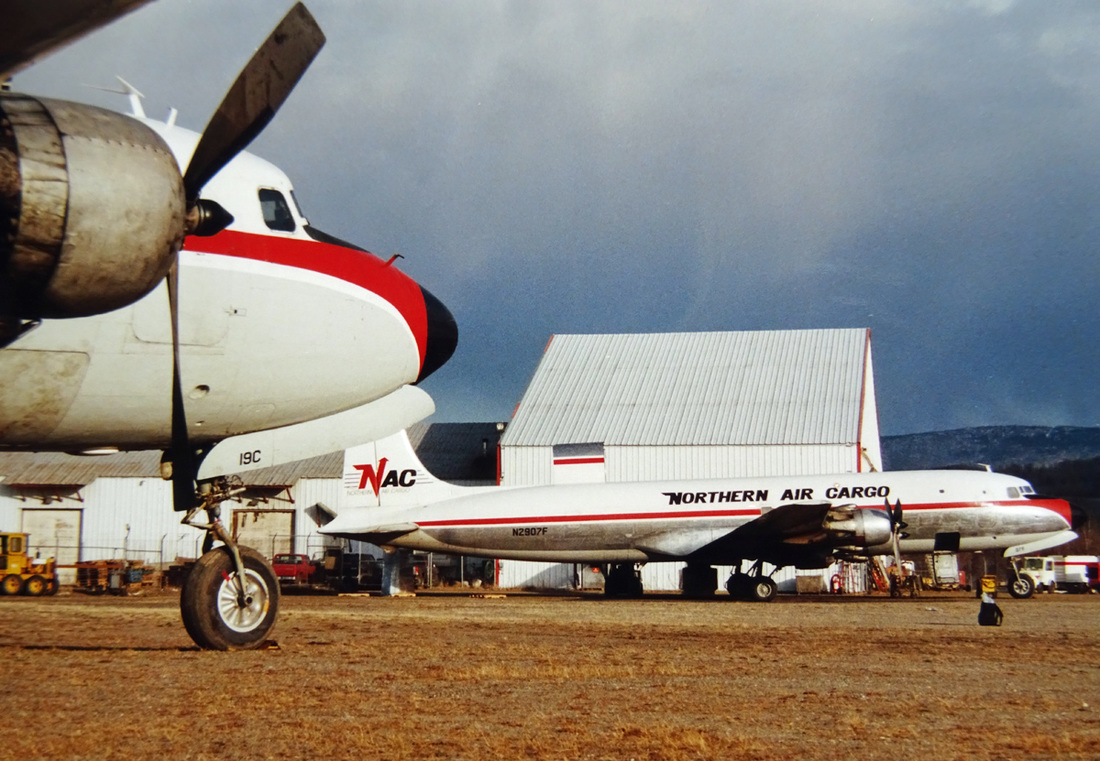Yukon 060 is Barrow bound
Come aboard for a flight up North in a Douglas DC-6
|
When working for KLM Cargo one is always surrounded by the modern screaming jets. Once a while the need for some aviation nostalgia must be fulfilled. Nowadays the choice is limited. Fortunately Alaska is a land with still a good number of operating Big Props. During the summer of 2000 I decided to pay this Greatland a visit.
After spending a couple of days at Anchorage I left for Fairbanks. There I was invited by Northern Air Cargo to ride aboard their DC-6 on the regular schedule to Barrow and Deadhorse, and have a closer look at their cargo operation. All Cargo. All the Time. Some airlines carry cargo as a sideline but at Northern Air Cargo, they do it for a living. It's been that way since they moved their first load in 1956. Over the years they have consistently provided customers in Alaska and the Pacific Northwest with a reliable means of shipping goods by air. Originally established as a charter air freight service, Northern Air Cargo pioneered air cargo transportation in Alaska. Using the unique C-82 'Flying Boxcar', they specialized in the delivery of outsized cargo to rural communities on a charter basis. Customers knew that if the cargo would fit in the airplane, and had access to a remote airstrip, NAC would get their load to them.... no matter what the cargo. From nuts and bolts to live animals. This "can-do" commitment to their customers continues today. In the summer of 2000, Northern Air Cargo operated the largest DC-6 fleet in the world. Besides these propliners the company operated in the year 2000, three Boeing 727 freighter jets. During those years NAC served more than 20 Alaskan cities with scheduled, all-cargo service, plus flagstop and charter flights to many other destinations. Their motto is 'All Cargo. All the Time" and judging from the cargo on their ramp at Anchorage and Fairbanks, they really mean it. Barrow bound I checked in as a fourth member of the crew for flight Yukon 060, on the early morning of May 02, 2000. Our captain proved to be Ken Zachary. A veteran who had learned to fly DC-3s at the age of 19! First Officer was Joe Holland and the Flight Engineer was Artic Wikle. Our full-load was described on the manifest as hard cargo and foodstuffs, and included several ski-scooters and a 3000 lbs. generator. Our aircraft for the flight was N2907F (c/n. 44636), built in 1955 as a C-118A for the US Air Force. It went to Davis-Monthan AFB, Arizona, for storage in the mid-1970s, before being auctioned off in May 1976. After a period of inactivity at Tucson it was converted to DC-6A standard and registrated to Time Aviation Services Company in 1978. '2907F' was bought by Northern Air Cargo in March 1991. Up till April 2000 it had logged a comparatively low 31,530 hours since new. By 08:30 local time, loading and all other departure formalities were completed, and 10 minutes later the four Pratt & Whitney Double Wasps were successively wounded-up amidst clouds of exhaust. Fairbanks ground control gave us our squawk ident, taxi and flight clearance. Our routing was to take us out over the Tanana River and then onto Barrow, via the Bettles intersection. We taxied out, with the familiar squeaking of brakes, to the run-up area. Following a lengthy check of all engines, "Yukon 060" was cleared for take-off on 19R. Ken rotated the DC-6 at 120 kts. and we established a steady climb at 500 ft/min. at 160 kts. IAS with full 2,400 rpm given by each engine. Our DC-6 banked gently over the Tanana river to establish on a heading of 299 degrees, on track for Barrow. After climbing for about 25 minutes, we levelled off at 10,000 feet and settled into a cruise to 2,200 rpm and the fuel flow to each of the roaring monsters eased to about 520 lb./hr. The Brooks mountain range The early May weather in Alaska is superb. The spring thaw is about to set in, and the lakes are still ice-covered. The sky is blue, the air clear. The snowy whiteness of the mountainous scenery is breathtaking. The Brook mountain range was 'on the nose' and after what seems an age it slipped below, just a couple of thousand feet away. The atmosphere in the cockpit was relaxed and topics such as women, guns, hunting and how to obtain a new set of Beech-18 wings, were the discussion items. Finally, we flew into a fairy land of whiteness - the Northern Slopes. We tuned into the Barrow weather - clear skies with a 15 kts. wind blowing the fallen snow into a kind of haze across the airfield. Oh yes, and an outside air temperature of -5 Fahrenheit (-21 degrees Celsius)! At 3,000 ft. the landing checks were completed and with an approach to runway 24 established, the flaps were set first to 20 degrees, then 30 degrees as the undercarriage was lowered with a loud, but reassuring clunk and three greens in the cockpit. With 6,500 ft of runway we rolled smoothly to a slow taxi speed and were arrived deep inside polar bear country. On went the iso-overalls, open went the side cargo door and unloading began. The crew virtually did the whole job, and in those conditions there was every incentive to get finished quickly. I could only manage the briefest excursions on the ground. The ride to Deadhorse With the loading virtually complete at 12:15, Ken and Joe set about the pre-flight preparations and checks. Artic closed the big rear cargo door and ensured that the cargo was well secured. The four Pratt & Whitney R-2800 Double Wasps were indepently started without recourse to a ground power unit and are started in the order 4, 3, 2, 1, number 4 being the starboard outer. Up in the cockpit everything was looking good so Ken commenced the start-up with a burst of throttle and a squeeze to the starter switches, then a pause before switching the ignition to 'both' and depressing the primer switch. With a whirring noise the prop blades turned over, the engine coughed and wheezed and with a big puff of exhaust sprang to life. With little trouble 3, 2 and 1 followed and they ticked over at 800 rpm using first primer fuel, then the mixture increased as the primer was reduced. After we received our clearance from air traffic control it was time to taxi to the end of the runway 06, for our 200 mile ride to Deadhorse. Just a fraction of Barrow's 6,500 ft runway passed beneath the DC-6 wheels before rotation. Our ascribed cruising level of 7,000 ft was reached after a sweeping left-hand turnout. After half an hour in flight we started our descend and turned right to Ocota beacon where we should have been at 1,600 feet. Along with the airport, the Trans Alaskan pipeline also came into view. Joe was flying this sector and despite having a long career as a bush-pilot on aircraft such as the Noorduyn Norseman, he still needed some blind landing training on the 'SIX'. After Deadhorse vectored us in for final to runway 22, Ken placed an aluminum plate in front of Joe's screen. We watched Joe grapple with the instruments down to short finals and saw through the left-hand cockpit window that we drifted too far from the center-line of the runway. Seconds later Ken removed the plate and Joe was a bit surprised at the sight of the aircraft's position. He immediately re-adjusted to the world outside and brought the DC-6, in a few seconds, back on track for a visual approach at 135 kts. with engines throttled back to a modest 1,500 rpm. Touch-down was by the book and the DC-6 rolled to a leisurely taxi speed to the end of the runway before a right turn to the apron and an assigned parking place, next to the end of the freight sheds. While Joe went out to buy some catering, we started unloading which was done with the help of a huge caterpillar truck. Return flight to Fairbanks Just twenty-five minutes after the Douglas arrival, '2907F' had been re-fueled, serviced and the uplifted cargo properly strapped in we were ready to go. We were cleared for runway 22 and minutes later we already climbed to 10,000 feet. The food Joe had brought with him was excellent. Tuna fish sandwiches, a choice of fresh fruit and a fine selection of soft drinks. What a difference with the usual coach-class snack onboard the big airliners! Half-an-hour out from Fairbanks the crew prepared for the descent and approach to runway 19R. We were established as number two to land behind the all-metal finished Brooks Fuel DC-4 (N90201). As we called finals, I took the chance to take a last look at the wide array of propliners based at Fairbanks airport, before we touched down at 14:20. Exiting the runway we taxied back to NAC's gravel ramp, at the end of what had been just another day's work for Ken, Joe and Artic but one of most memorable aviation experience for their grateful and happy fourth crewmember. |
|
Our full-load was described on the manifest as hard cargo and foodstuffs, and included several ski-scooters and a 3000 lbs. generator
Apron scene at NAC's Fairbanks base depicting four of the airline's DC-6s
Ken and Joe at the controls of N2907F.
The Brooks mountain range was 'on the nose'.
N2907F ammassed 31,530 hrs. during our flight to Deadhorse
Our DC-6 establish on a heading of 299 degrees, on track for Barrow
The atmosphere in the cockpit was relaxed
Fuel flow during cruise to each of the roaring monsters is about 520 lb./hr.
After half an hour in flight we started our descend and turned right to Ocota beacon where we commenced our approach to Deadhorse
Harsh operating conditions are experienced by the airline operators in this inhospitable continent
In the Artic there are still signs of the once Alaskan independent Markair, as here on a Deadhorse cargo shed.
Artic at work in sub-zero temperatures.
NAC N2907F awaits her load at Deadhorse on the early afternoon of May 02, 2000
Other Deadhorse visitors were an Alaska Airlines Boeing 737-200 Combi and British Petroleum
Boeing 737-200 N736B, which is operated by the Atlantic Richfield Company.
Boeing 737-200 N736B, which is operated by the Atlantic Richfield Company.
Just 25 minutes after the Douglas arrival, '2907F' had been re-fueled and the uplifted cargo properly strapped in we're ready to go
Back 'Home' at Fairbanks
Dormant Douglas Swing-tail DC-6 N434TA of NAC, languishes at Fairbanks
Once the pride of KLM Royal Dutch Airlines, DC-6 N7919C now rests beside's the NAC Cargo shed at Fairbanks Airport
This is former KLM Royal Dutch Airlines flagship PH-TFM 'Olivier van Noort'
N4206L is a former US Navy R6D-1
N2907F being loaded at Fairbanks for her up-coming cargo flight to Barrow and Deadhorse on May 05, 2000.
The early May weather in Alaska is superb. The spring thaw is about to set in, the sky is blue and the air clear.









